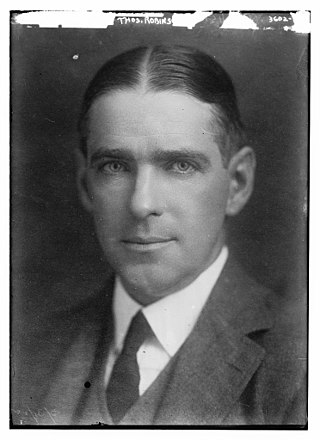Top Qs
Timeline
Chat
Perspective
Thomas Robins (inventor)
American inventor From Wikipedia, the free encyclopedia
Remove ads
Thomas Robins Jr. (September 1, 1868 – November 4, 1957) was an American inventor and manufacturer.[1]
Remove ads
Biography
He was born on September 1, 1868, in West Point, New York to Thomas Robins Sr. He attended Princeton University.[2]
Career
In 1891, Robins began work on a conveyor belt for carrying coal and ore for Thomas Edison and his Edison Ore-Milling Company in Ogdensburg, New Jersey.[3] His conveyor belt received the grand prize at the Paris Exposition in 1900, and first prizes at the Pan-American Exposition and Saint Louis Exposition.[2]
Based on his invention, Robins started the Robins Conveying Belt Company and of the Robins New Conveyor Company (now ThyssenKrupp Robins).[3] In 1915 he was appointed to the Naval Consulting Board.[2]
Remove ads
Personal life
Summarize
Perspective
On April 26, 1894, Robins married Winifred Hamilton Tucker (1868–1952)[4] in Boston, Massachusetts. They lived together at 40 East 66th Street in New York City and had a home in Stamford, Connecticut, called Saddle Rock House designed by prominent New York City architects, Hunt and Hunt.[5] Together with his wife, he had:
- Thomas Robins III "Jr" (1897–1977),[6] who in 1939 married Louisa Winslow Cogswell (1899–1962), an artist.[7] She was the daughter of Cullen Van Rensselaer Cogswell and Agnes Eugenia Nickerson. Her paternal grandparents were Andrew Kirkpatrick Cogswell (1839–1900) and Mary Van Rensselaer Cogswell (1839–1871). After her death, he married Eileen Burden Maynard (1910–1970), daughter of Cynthia Roche (1884–1966) and the granddaughter of James Roche, 3rd Baron Fermoy (1852–1920) and Frances Ellen Work (1857–1947)[6]
- Louisa Robins (1920–1992), who married Austin Goodyear (1920–2005) in 1939.[8] After their divorce, Goodyear married Sara Suleri[9]
- Grace Rumsey Goodyear (b. 1941), who in 1962 married Franklin Delano Roosevelt III (b. 1938), grandson of Franklin Delano Roosevelt and Eleanor Roosevelt[10][11]
- Phoebe Louisa Roosevelt (b. 1965)
- Nicholas Martin Roosevelt (b. 1966)
- Amelia "Amie" Roosevelt (b. 1966)
- Cullen Goodyear, a noted triathlon athlete[12]
- Thomas R. Goodyear, who was married to Barbara Marshall (1946–2007)[13]
- Grace Rumsey Goodyear (b. 1941), who in 1962 married Franklin Delano Roosevelt III (b. 1938), grandson of Franklin Delano Roosevelt and Eleanor Roosevelt[10][11]
- Mary Van Rensselaer Robins (1919–2006), who married Dr. Stephen Goodyear (1915–1998). They divorced in 1963[14] and in 1964, Mary married Julian McKee (1918–2006)[6][15]
- Anne Davis Robins, who married Evan W. Thomas II[7][16][17] in 1943,[18] son of Norman Thomas and Frances Violet Stewart.
- Evan Welling Thomas III (b. 1951)
- Louisa Robins (1920–1992), who married Austin Goodyear (1920–2005) in 1939.[8] After their divorce, Goodyear married Sara Suleri[9]
- Samuel Davis Robins, who married Emma Lawrence Jacob[19] in 1925. She was the daughter of Bartholomew Jacob. One of Robin's groomsmen was Frederic W. Lincoln IV[20] Jacob later married Joseph R. Busk[21] in 1937[22]
He died on November 4, 1957, at the Nestledown Convalescent Home in Stamford, Connecticut, aged 89.[1]
Remove ads
References
Wikiwand - on
Seamless Wikipedia browsing. On steroids.
Remove ads

